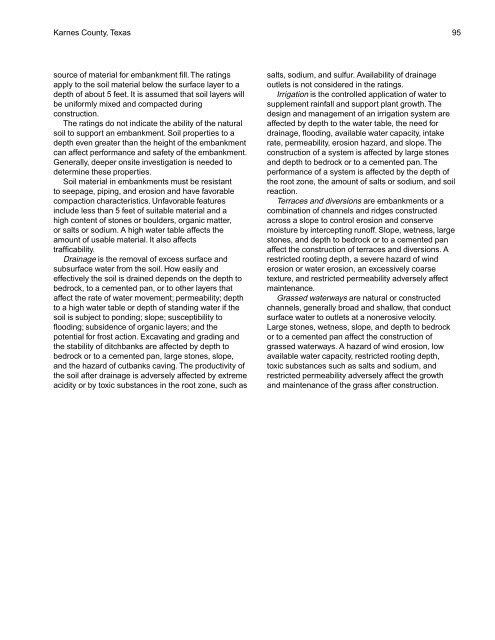Soil Survey of Karnes County, Texas - Soil Data Mart - US ...
Soil Survey of Karnes County, Texas - Soil Data Mart - US ...
Soil Survey of Karnes County, Texas - Soil Data Mart - US ...
Create successful ePaper yourself
Turn your PDF publications into a flip-book with our unique Google optimized e-Paper software.
<strong>Karnes</strong> <strong>County</strong>, <strong>Texas</strong> 95<br />
source <strong>of</strong> material for embankment fill. The ratings<br />
apply to the soil material below the surface layer to a<br />
depth <strong>of</strong> about 5 feet. It is assumed that soil layers will<br />
be uniformly mixed and compacted during<br />
construction.<br />
The ratings do not indicate the ability <strong>of</strong> the natural<br />
soil to support an embankment. <strong>Soil</strong> properties to a<br />
depth even greater than the height <strong>of</strong> the embankment<br />
can affect performance and safety <strong>of</strong> the embankment.<br />
Generally, deeper onsite investigation is needed to<br />
determine these properties.<br />
<strong>Soil</strong> material in embankments must be resistant<br />
to seepage, piping, and erosion and have favorable<br />
compaction characteristics. Unfavorable features<br />
include less than 5 feet <strong>of</strong> suitable material and a<br />
high content <strong>of</strong> stones or boulders, organic matter,<br />
or salts or sodium. A high water table affects the<br />
amount <strong>of</strong> usable material. It also affects<br />
trafficability.<br />
Drainage is the removal <strong>of</strong> excess surface and<br />
subsurface water from the soil. How easily and<br />
effectively the soil is drained depends on the depth to<br />
bedrock, to a cemented pan, or to other layers that<br />
affect the rate <strong>of</strong> water movement; permeability; depth<br />
to a high water table or depth <strong>of</strong> standing water if the<br />
soil is subject to ponding; slope; susceptibility to<br />
flooding; subsidence <strong>of</strong> organic layers; and the<br />
potential for frost action. Excavating and grading and<br />
the stability <strong>of</strong> ditchbanks are affected by depth to<br />
bedrock or to a cemented pan, large stones, slope,<br />
and the hazard <strong>of</strong> cutbanks caving. The productivity <strong>of</strong><br />
the soil after drainage is adversely affected by extreme<br />
acidity or by toxic substances in the root zone, such as<br />
salts, sodium, and sulfur. Availability <strong>of</strong> drainage<br />
outlets is not considered in the ratings.<br />
Irrigation is the controlled application <strong>of</strong> water to<br />
supplement rainfall and support plant growth. The<br />
design and management <strong>of</strong> an irrigation system are<br />
affected by depth to the water table, the need for<br />
drainage, flooding, available water capacity, intake<br />
rate, permeability, erosion hazard, and slope. The<br />
construction <strong>of</strong> a system is affected by large stones<br />
and depth to bedrock or to a cemented pan. The<br />
performance <strong>of</strong> a system is affected by the depth <strong>of</strong><br />
the root zone, the amount <strong>of</strong> salts or sodium, and soil<br />
reaction.<br />
Terraces and diversions are embankments or a<br />
combination <strong>of</strong> channels and ridges constructed<br />
across a slope to control erosion and conserve<br />
moisture by intercepting run<strong>of</strong>f. Slope, wetness, large<br />
stones, and depth to bedrock or to a cemented pan<br />
affect the construction <strong>of</strong> terraces and diversions. A<br />
restricted rooting depth, a severe hazard <strong>of</strong> wind<br />
erosion or water erosion, an excessively coarse<br />
texture, and restricted permeability adversely affect<br />
maintenance.<br />
Grassed waterways are natural or constructed<br />
channels, generally broad and shallow, that conduct<br />
surface water to outlets at a nonerosive velocity.<br />
Large stones, wetness, slope, and depth to bedrock<br />
or to a cemented pan affect the construction <strong>of</strong><br />
grassed waterways. A hazard <strong>of</strong> wind erosion, low<br />
available water capacity, restricted rooting depth,<br />
toxic substances such as salts and sodium, and<br />
restricted permeability adversely affect the growth<br />
and maintenance <strong>of</strong> the grass after construction.
















